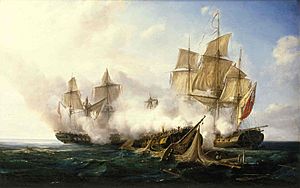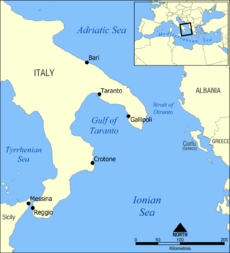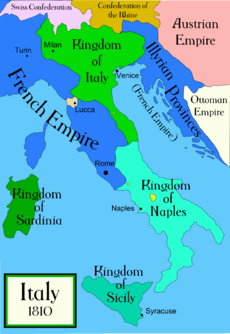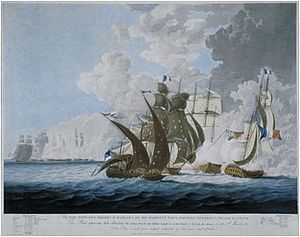Adriatic campaign of 1807–1814 facts for kids
Quick facts for kids Adriatic campaign of 1807–1814 |
|||||||
|---|---|---|---|---|---|---|---|
| Part of the Napoleonic Wars | |||||||
 La Pomone contre les frégates HMS Alceste et Active, Pierre Julien Gilbert |
|||||||
|
|||||||
| Belligerents | |||||||
| Commanders and leaders | |||||||
The Adriatic campaign was a series of naval battles and operations during the Napoleonic Wars (1807-1814). It took place in the Adriatic Sea. British and Austrian navies fought against the combined forces of the First French Empire, the Kingdom of Italy, the Illyrian Provinces, and the Kingdom of Naples.
These areas were controlled by Napoleon I. He had gained them after the Treaty of Pressburg in 1805. Controlling the Adriatic Sea was important for France. It allowed them to move troops quickly from Italy to the Balkans and Austria. France also gained access to important shipbuilding places like Venice.
After 1807, France had strong naval control in the region. This was due to the Treaty of Tilsit. This treaty made Russia leave the Septinsular Republic. The treaty also had a secret part. It promised French help if Russia fought the Ottoman Empire. To do this, Napoleon needed safe supply lines to the east. This meant controlling the Adriatic Sea against British attacks. The British Navy wanted to stop French troop movements. They also wanted to break France's power in the region. This led to a six-year naval fight.
The campaign changed over time. Both British and French forces were limited by the larger wars happening. So, the number of ships changed often. Many commanders led forces, but two were very important: William Hoste for the British and Bernard Dubourdieu for the French. Their actions were often reported in newspapers. The fighting between them reached its peak at the Battle of Lissa in March 1811. Dubourdieu was killed, and Hoste's squadron won a famous victory.
After 1811, the British were in charge of the Adriatic Sea. British and Greek forces captured French islands. Their raids caused problems for trade in the area. French plans against the Ottoman Empire were stopped. Napoleon's army, La Grande Armée, then turned towards Russia. British forces kept fighting until 1814. The armies of the Sixth Coalition pushed the French out of the Adriatic. British troops helped capture important French cities like Fiume (Rijeka) and Trieste.
Contents
Why the Adriatic Sea Was Important
France had been present in the Adriatic Sea since 1797. This was after the Treaty of Campo Formio during the French Revolutionary War. This treaty ended the War of the First Coalition. It also meant the end of the independent Republic of Venice. Its land was split between France and the Austrian Empire. France gained the seven Ionian Islands. These islands controlled the entrance to the Adriatic.
These French outposts were seen as a threat by both Russia and the Ottoman Empire. In 1798, a combined Russian and Ottoman force attacked the French fort on Corfu. It fell in 1799 after a four-month siege. The winners took the islands. They created the Septinsular Republic. This republic was technically Ottoman but mostly independent. It was protected by the Russian Navy.
Napoleon Bonaparte became the ruler of the new French Empire. This led to a new war, the War of the Third Coalition in 1805. Austria and Russia lost badly at the Battle of Austerlitz. The treaties that ended the war created two French-controlled kingdoms in Italy. These were the Kingdom of Italy and the Kingdom of Naples. French troops also held parts of the Adriatic coast in Dalmatia. This made the Adriatic Sea very important for the French Navy. It had many good ports and shipbuilding places, especially at Venice.
The Russian soldiers on Corfu, with their strong navy, blocked French use of the Adriatic. They controlled the entrance through the Straits of Otranto. France was also busy fighting in the north. This led to the War of the Fourth Coalition in 1806-1807. Napoleon's armies defeated Prussia and forced Russia to sign the Treaty of Tilsit on July 7, 1807. A small part of this treaty gave the Ionian Islands back to France. Russia completely left the Adriatic. This helped a secret part of the treaty. It promised French help in Russia's ongoing war with the Ottomans.
The Campaign Begins
First Battles in the Adriatic
As Russia left, France quickly sent soldiers to the Ionian Islands. They gathered over 7,400 French and Neapolitan troops on Corfu alone. This made the Adriatic Sea a safe French area. From here, they could send ships to attack British convoys and blockades. To help with this, the French Navy ordered many ships from the Venetian shipyards. They wanted to build up their forces with local ships and crews.
The British Navy's Mediterranean Fleet quickly reacted. In November 1807, the ship HMS Glatton and smaller ships blocked Corfu. They captured several French and Italian supply ships. Encouraged by this, small British ships started entering the Adriatic on their own. They attacked French ships along the Italian coast. One early British action was taking the small Dalmatian Island of Lissa. They used it as a safe harbor deep inside French-controlled waters. The island quickly became a naval base. A town and harbor were built at Port St. George.
In 1807, British ships in the Adriatic were small. Their impact was minor. British attackers also only targeted military sites on the Illyrian coast. This was to keep the support of local people. These locals supplied the British ships with food and water. The French Mediterranean Fleet, led by Admiral Ganteaume, sailed to Corfu in February 1808. The British ships could not stop them. But this was the only time France sent large warships to the area. The fleet returned to Toulon by mid-March.
The first big British deployment to the Adriatic was in May 1808. The frigate HMS Unite under Captain Patrick Campbell arrived near Venice. Campbell greatly disrupted French and Italian shipping. He captured three ships sent against him by the Italian Navy. France sent the small frigate Var to Venice. This did not stop British operations much. However, British activity in the Adriatic was reduced that year. This was because of the British war with the Ottoman Empire. This war used up British naval resources in the Eastern Mediterranean.
Taking the Ionian Islands
The British presence in the Adriatic became much stronger in 1809. The frigates HMS Amphion under William Hoste and HMS Belle Poule under James Brisbane arrived. These new ships quickly made a difference. They launched many raids in the Dalmatian and Ionian islands. In February, Belle Poule captured the Var near Valona. France sent the frigates Danaé and Flore from Toulon. HMS Topaze attacked these frigates as they arrived. But they reached Corfu and then sailed north to help French defenses.
Throughout 1809, British attacks grew stronger. Hoste's Amphion operated from Lissa. Raids on the Italian coast captured many merchant ships and gunboats. Groups of marines and sailors landed at coastal towns. They drove off defenders and blew up forts. Then they returned to their ships. These successes, with little French resistance, encouraged the British commander. Admiral Cuthbert Collingwood decided to send a force to remove French soldiers from the Ionian Islands.
This expedition was led at sea by Brigadier-General John Oswald. He was on HMS Warrior. On October 1, they landed on Cefalonia. The Neapolitan soldiers there surrendered within hours. Within days, the nearby islands of Zante and Ithaca also surrendered. The frigate HMS Spartan under Jahleel Brenton successfully invaded Cerigo soon after.
These islands had small groups of soldiers. A few French soldiers and more men from the Albanian Regiment defended them. These forces were too small to fight well. Captured men were sent to Italy as prisoners. But many Albanian Regiment men simply ran into the countryside. They went back to their old fighting ways. Most of these escapees, and those captured, soon joined the British. They formed the 1st Regiment Greek Light Infantry. Over 70% of the Albanian Regiment men on the four islands switched to the British. This included most of their officers. The 1st Regiment Greek Light Infantry, led by Richard Church and later Robert Oswald, attracted many Greek military leaders. These leaders later played a key role in the Greek War of Independence. One famous leader was Theodoros Kolokotronis.
Some troops were moved away in late 1809. This delayed more invasions until March 1810. Then, Collingwood's temporary replacement, Thomas Byam Martin, sent a squadron to attack Santa Maura. Landings happened on March 22. The island surrendered on April 16. This was after an eight-day siege of the main fort. The attackers were greatly helped by Greek soldiers leaving the French side to join the British. Along with a 2nd Regiment formed in 1813, these Greek units helped capture Paxoi and Parga. They also helped in the Allied capture of Genoa in 1814.
French Fight Back
The end of the War of the Fifth Coalition in late 1809 changed things in the Adriatic. It confirmed France's control of the Illyrian Provinces. It also removed any threat to Adriatic ports from Austrian land. This also allowed the French Army to fight the Ottoman Empire, as planned in the Treaty of Tilsit. However, it did not stop British frigates raiding the Adriatic under William Hoste. He was now leading attacks on coastal convoys, towns, and forts along the Italian coast.
In late summer 1810, the French Navy made its first serious effort to challenge the British. They sent Bernard Dubourdieu from Toulon in Favorite. Dubourdieu was known as one of the best French frigate commanders. He gathered French and Italian forces across the Adriatic. His squadron was much larger than Hoste's forces. Hoste knew about Dubourdieu's movements. He kept a close watch on the French squadron at its base in Ancona.
In early October, Hoste had failed to get Dubourdieu to fight the month before. He resupplied at Lissa and returned to block Ancona. Now, HMS Cerberus was with him. Hoste found Dubourdieu and his squadron gone. Hoste chased them towards Corfu. He was acting on wrong information from a passing Sicilian privateer (a privately owned warship). As Dubourdieu had planned, this detour left Lissa open to attack.
Dubourdieu landed on Lissa with many soldiers on October 21. The French took the ships in the harbor. But they could not find the island's soldiers, who had gone into the mountains. Dubourdieu stayed on Lissa for seven hours. But he went back to Ancona when local fishermen told him Hoste was returning. To stop another raid and to guard against the French ship Rivoli (being finished in Venice), the British Mediterranean Fleet sent HMS Montagu to Lissa. This powerful ship stopped any more French actions that year. This allowed Hoste to continue small raids on the Italian coast.
The Battle of Lissa
In early 1811, Montagu left the Adriatic. HMS Cerberus and HMS Active were sent to attack the ports of Pescara and Ortona in February. Dubourdieu then planned a second attack on Lissa. This time, he wanted to take the island for good and put Italian soldiers there. He left Ancona on March 11 with six frigates, many support ships, and over 500 soldiers. The French-Italian squadron sailed for Lissa overnight. Early on March 12, British observers on Lissa saw the French. Hoste brought his squadron, including the recently returned Cerberus and Active, to meet Dubourdieu off the island's north coast.
Hoste kept his ships in a tight line. This forced Dubourdieu to attack him directly. Dubourdieu tried to board Hoste's Amphion himself, leading the Italian soldiers. Hoste fired back with a carronade (a short, powerful cannon) at very close range. It was loaded with over 750 musket balls. The first shot killed Dubourdieu and almost all his officers. This caused confusion in the French squadron. As a result, Favorite crashed onto Lissa's coast. Hoste then fought the next ships, Flore and Bellone, forcing them to surrender.
The front of the British line, led by HMS Volage, fought the three remaining French and Italian ships. They drove off Danaé and Carolina. They also captured Corona. Flore later escaped to the safety of French forts near Lesina.
The British victory at the Battle of Lissa confirmed their control in the region for the next three years. The French could not replace the ships and experienced officers they lost. France tried to send more ships and supplies to Corfu from Toulon in spring 1811. But few reached the Adriatic. They were stopped by the British blockade of southern French ports. Most that escaped the Toulon blockade were later captured by the squadron at Lissa. This squadron had been strengthened by the return of HMS Belle Poule and the new HMS Alceste. These replaced HMS Amphion and the wounded Hoste, who had returned to Britain. The squadron also continued raiding coastal shipping and towns. They attacked Parenzo and Ragosniza to destroy supply ships.
In November, HMS Eagle chased and captured the small French frigate Corcyre. This was part of a failed French attempt to bring supplies to Corfu. A day later, the action of 29 November 1811 stopped the most important French attempt to send more forces to the Adriatic in 1811. A British squadron under Captain Murray Maxwell in Alceste chased and fought two frigates and an armed supply ship. One frigate and the supply ship were captured. The other frigate reached Ancona in a damaged state. This battle had big effects. Napoleon himself was interested in the reports. Some believe this battle convinced him to change his plans for expansion. Instead of the Balkans, he turned his attention to Russia for his 1812 campaign.
British Control the Adriatic
French hopes of regaining control in the Adriatic now depended on the Rivoli. This was a large warship being built in Venice. Its completion had been delayed for almost two years. But British spies knew about it. British warships were sent to watch it and attack if possible. In February 1812, Rivoli left Venice for the first time. It was going to Pola on its first trip. Waiting for Rivoli was the British ship HMS Victorious. It was commanded by John Talbot. He chased Rivoli and captured her in a four-hour battle. Both sides had many casualties.
The loss of Rivoli ended French efforts to challenge British control of the Adriatic. The campaign continued until 1814. But from February 1812, British ships could attack French convoys, forts, islands, and even large cities without fear. In summer 1812, William Hoste returned to the Adriatic. He was captain of HMS Bacchante. He raided the Apulian coast for several months. The ease with which British ships could operate attracted more ships from the Mediterranean Fleet. For example, HMS Eagle arrived near Ancona in September. It blocked the city, chasing and destroying whole coastal convoys without opposition.
Even without British attacks, French losses in the Adriatic grew. In November 1811, the Flore, a ship from Lissa, was wrecked near Chioggia. In September 1812, the Danaé suddenly exploded at Trieste, with many lives lost. For the French Navy, these losses could not be replaced. French frigates found it harder to escape blockades of their home ports. This made it difficult to protect their convoys in the Adriatic.
In early 1813, the first large British squadron was sent to the Adriatic. It was commanded by Admiral Thomas Fremantle. This force had broad orders. They were to capture or destroy all French islands, forts, and outposts. They also had to disrupt coastal trade and help the allied armies of the Sixth Coalition. Under Fremantle's orders, islands and towns were systematically invaded. These included Lagosta, Curzola, Carlopago, Cherso, Dignano, Giuppana, and others. They were either held by British forces or had their defenses destroyed.
Fremantle also sent several officers, including Hoste, to operate independently. Hoste in Bacchante returned to Apulia. He attacked many ports, castles, and anchorages. Captain George Cadogan in HMS Havannah effectively stopped supplies moving along the northern Italian coast. This helped the approaching Austrian armies. In June, Fremantle himself led his whole squadron against the important port city of Fiume. They captured or burned 90 vessels and huge amounts of naval supplies. This happened after a sharp battle in the city streets. Three months later, Fremantle attacked the city of Trieste. He blocked it from the sea, bombed its defenses, and landed marines and cannons. They joined the Austrian armies besieging the city and forced its surrender.
The End of the Campaign
In autumn 1813, British ships completely controlled the Adriatic Sea. They worked with the Austrian armies, who were now invading the Illyrian Provinces and Northern Italy. Fremantle's ships could quickly move British and Austrian troops. This led to the surrender of the important port of Zara in December. Cattaro was captured with the help of Montenegrin ground troops. The same happened at Ragusa in January 1814. By February 16, 1814, Fremantle wrote to his superior Sir Edward Pellew. He said that every French harbor had been captured by British or Austrian troops. Over 700 French merchant ships had been seized. The only French outpost left was Corfu. The last French warship in the region, the frigate Uranie, was destroyed by its own crew at Brindisi on February 3. This was to stop it from being captured by the British.
Napoleon's abdication in early April 1814 ended the War of the Sixth Coalition. Corfu, the longest-held French territory in the Adriatic, surrendered. It was added to the United States of the Ionian Islands under British protection.
What Happened Next
Many awards were given in Britain for service in the Adriatic. Hoste, Maxwell, and Fremantle were knighted in 1815. They also received a lot of prize money for the ships they captured. There were not many big fleet battles in the last nine years of the war. This made battles like Lissa very popular. They were celebrated both during and after the war.
Impact of the Campaign
The Adriatic campaign was a smaller part of the Napoleonic Wars. But it might have had big effects on the wider conflict. Napoleon himself studied the events of 1811 closely. In 1817, he met Murray Maxwell by chance. The former Emperor remembered Maxwell's battle on November 29, 1811, in detail. He praised Maxwell for his victory.
France and Russia had agreed to help each other against the Ottoman Empire. This plan needed safe supply lines from France to the Balkans. These supply lines needed naval control of the Adriatic. Historian James Henderson has connected the battle of November 1811 to this problem. He suggests that losing the convoy and its 200 cannons might have made Napoleon change his plans. Instead of the Balkans, he decided to invade Russia in 1812.
On a smaller scale, the Adriatic was one of the few places where French and British ships fought regularly. Rivoli was the last French warship captured in battle at sea. The French Mediterranean Fleet had to send many ships to the Adriatic. This was to supply the isolated soldiers on Corfu. This frustrated French admirals, especially after Dubourdieu's death in 1811. The British blockade of Toulon stopped France from rebuilding its forces. By 1812, British ships could operate almost freely. This kept thousands of French and Italian soldiers stuck in garrisons along the coast. These soldiers could have been fighting the Sixth Coalition. In the final months of the war, the British Navy could attack any point on the coast without resistance. This weakened French defenses. It also made it easier for the Austrian armies to capture several heavily defended port cities.





